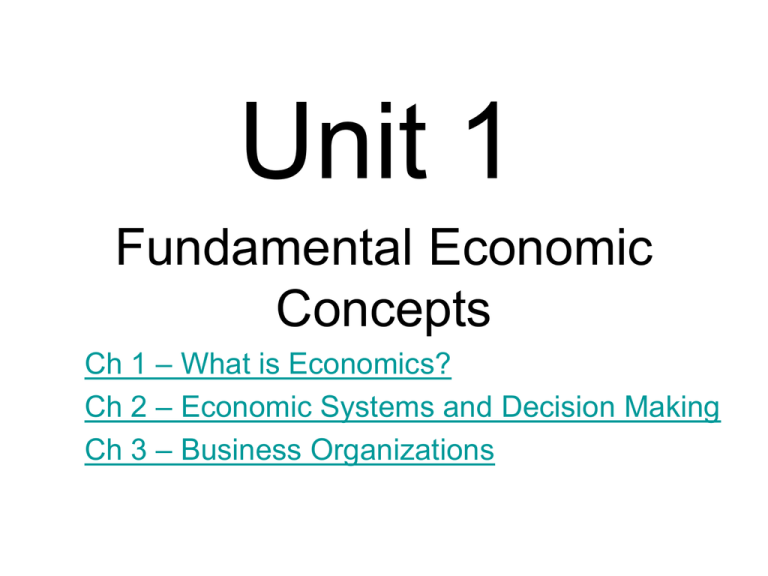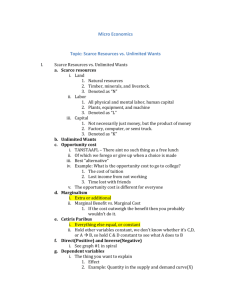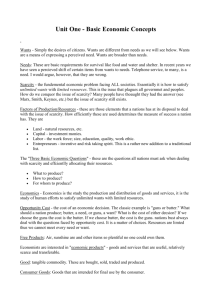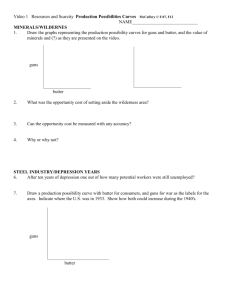Economics
advertisement

Unit 1 Fundamental Economic Concepts Ch 1 – What is Economics? Ch 2 – Economic Systems and Decision Making Ch 3 – Business Organizations Ch 1 – What is Economics? • So why study • Virtually _________, + certainly every economics? _____, wants more than it can obtain. B/c we have limited ___________ but unlimited ____/_____, the problem of _________ arises. • ______________________________________ _________________ • Scarcity is the problem of not having enough ____________ to meet our limitless needs/wants. • Economics is the study of how people try to _____ their needs/wants w/ limited __________. • Needs vs. wants • A need is a basic requirement for ___________. • Includes ______, food, clothing, + _______. • A want is a way is a way of _________ a _______. • Includes soda, juice, pizza, fries, a leather jacket, pants 10 sizes too big, a mansion, a yacht, etc… • The 3 basic economic _________: • B/c of scarcity, societies must deal w/ 3 economic questions: 1. ________ to produce? • Guns vs. butter 2. _______ to produce? • __________ vs. _______ 3. ___________ to produce? • How to decide who gets what (based on who can _____ it, who needs it the most, who ______ it, etc). • There is no such thing as a ______ ________! TINSTAAFL • Everything ______ something. A Production Possibilities Curve Butter 1 pound 15 A of butter 14 2 pounds of butter 12 B C D 9 5 E 5 pounds of butter 0 4 4 guns 7 3 guns 9 F 11 12 Guns 1 gun Answering the Basic Economic Questions What? How? For Whom? ______________ 1. Sweden passes a law providing free medical care for all citizens. ______________ 2. Ford Corporation decides to reintroduce the convertible automobile. ______________ 3. All toys at the Toys-R-US factory are made by hand. ______________ 4. General Motors replaces assembly-line workers with robots at its Pontiac plant. ______________ 5. A company decides to extend dental insurance to their workers’ dependents ______________ 6. South American farmers decided to start growing coffee beans. Unlimited Wants/Needs fuels for transportation, electricity for home appliances, home heating & cooling, fuels for industrial machinery Limited Resources amount of coal, oil, and natural gas capital Create Economic Problem of Scarcity higher prices for oil, gas, electricity, disruption of transportation systems, power outages, heating shortages, cutbacks of industrial & agricultural production. Forcing People to make Choices alternative energy sources, planned development, conservation, rationing, suffering WHAT to Produce HOW to Produce For WHOM to Produce solar power Schools, hospitals, malls….. hydropower current & develop new technology • The 4 factors • The basic ________ required to produce of production: all _______ + __________. • These are necessary in every ________: Land – includes all “________________” land, water, natural resources (like diamonds, oil, iron, etc…) Entrepreneurs – someone who brings together all of the other factors + _________ them to produce goods or offer services The Factors of Production They take the ______ doing something new + aren’t considered part of _____ Capital – ________ made resources (such as buildings, equipment, tools, machinery, services, $, etc) Labor – people + their __________ The only factor that assists in production + is a ________ of earlier production • What do • _________ economic activity economists (measuring GDP, ______________, do? inflation, gov.’t _________, etc). • __________ economic activity (Why are some prices _______ than others? Why are some people ____ more than others? How do taxes effect how much people work + _______?). • _____ economic activity (Communicate issues to help societies understand _________ + reach ______________). • ______ economic activity (Will incomes rise or fall? What happens if ___________ are taxed more instead of homeowners? Is the economy _____________?). End Section 1 • Definitions • Consumer goods – goods intended for final use by ___________. • Capital goods – goods used to __________ other goods/services. • Ex. Ovens, cash registers, etc. • Wealth – in an economic sense, it is the accumulation of all __________ which are _______, scarce, useful, + _________ from one person to another. • A nation’s wealth includes natural resources, ________, stores, houses, books, ____________, furniture, etc… • _________ are not considered wealth, but instead the _________ of wealth. • Market – a location or other mechanism that allows _______ + ________ to exchange a certain economic product(s). • Includes __________ markets. • Division of labor or specialization – assignment of _______ so that each worker performs ____ functions more ____________. • ___________ • Ex. Henry Ford’s ____________ • Economic interdependence – relying on others to help ________ goods + services we _________. • Human capital is the sum of the skills, _________, health, + __________ of people. • How can a nation its human capital? Effect of Education on Income (2003): Education: Average Income For: Males Females Less than 9th grade $ 25,112 $ 18,227 9th to 12th grade (No diploma) $ 30,656 $ 23,625 High school graduate $ 39,017 $ 27,525 Some college (No degree) $ 46,696 $ 33,002 Associate Degree $ 48,153 $ 34,560 Bachelor’s Degree $ 71,361 $ 45,778 Master’s Degree $ 87,099 $ 57,874 Professional Degree $ 130,764 $ 72,689 Doctorate Degree $ 104,237 $ 70,302 End Section 2 • Trade-offs • Alternate _______ which must be given up when one is chosen rather than another. • Ex. You have $100. If you buy concert tickets w/ the money, the trade-off isn’t $100, but a new pair of sneakers, an i-phone, or anything else you could have used that $100 for. • It’s what you are _____________. • Opportunity cost • The cost of the __________ alternative use of $, time, or resources when one choice is made instead of another. • Ex. If you use gas instead of solar energy, it’s not just the gas you’re burning but the pollution to the environment as well. • It’s the ___________, but not just in $. Increasing Opportunity Cost • Production possibility frontier • A diagram representing various ____________ of goods +/or services an economy can produce when all productive resources are _______ ___________. • It shows that: • There is a _____ to what you can __________ given existing institutions, resources, + _____________. • Every ______ has an opportunity cost – you can get more of something only by ___________ something else. • All points on and below the production curve are ___________. • At points A + B all resources are fully employed + ___________ ________ is achieved. • Point C, while possible, is an ___________ option. • Point D is not a __________ option given current technology, resources, + labor force. • Economic growth • Can occur due to various factors such as __________ growth, technology is __________, more resources are ___________, etc… Production Economic The economy growth is initially can results now at point in an(20 produce A outward fishmore and shift of 25of everything. coconuts), the PPF it can production move to point E (25 because possibilities fish and 30 coconuts). are expanded. End Section 3 Ch 2 – Economic Systems and Decision Making • Economic systems • An economy or economic system is an _____________________ for the wants + needs of a society’s people. • The way in which a society ________ the 3 economic questions (What, How, + For whom?) determines what type of economic system it has (traditional, ________, or command) • Traditional economies • In these societies, the allocation of _________ resources, + nearly all other economic activity, comes from ______, habit, or custom. Habit + custom also dictate most social ___________. • _______ answers the What, How, + For Whom to produce. So individuals are not ___ to make decisions based on what they want or would like to have. Their roles are _________ by the customs of their __________. • Ex. the _____ of Canada, the ___________ of Australia, + the Mbuti of Africa. • Advantages: everyone knows their _______ in society + little ____________ exists over what, how, or for whom to produce, + usually _____. • Disadvantages: discourages new ____ + ways of doing things, strict rules of society ________ those who act differently or break the rules, + lack of _________ leads to a lower standard of living than in other economic systems. • Command economies • In these societies, a _____________ makes most of the economic decisions + the people have little, if any, _________. • The _______ answers the What, How, + For Whom to produce. Individuals are not ___ to make decisions based on what they want to have + their roles are defined by the _____. • Ex. North Korea, Cuba, the former USSR. • Advantages: it can change drastically in a relatively _________ + many health + other public services are provided for everyone at little or no ____ (although quality may not be _______). • Disadvantages: not ________ to meet the wants of consumers, no _______ for people to work hard, requires a large decisionmaking _______________, doesn’t have the _________ to deal w/ minor day-to-day problems, + new _______ are discouraged. • Market economies • In these societies, _____ + ____ act in their own best interests. Buyers + sellers come together to __________ goods + services. • _________ + _________ answer the What, How, + For Whom to produce. • Includes the largest + most _____________ economies in the world. Ex. The US, Japan, South Korea, Britain, Germany, etc… • Advantages: can adjust to _____ over time, high degree of individual _______, relatively small degree of gov.’t interference, decision making is ___________ (we all have a say), wide _______ of goods + services, + a high degree of consumer _____________. • Disadvantages: doesn’t provide for the ____ needs of everyone in the society, doesn’t provide enough of the goods + services that people value ____, relatively high degree of ___________ workers + businesses face, + must guard against market failures. End Section 1 • Economic + social goals • Economic ________ – the freedom to make your own economic _______ (where to work, what to buy, whom to hire, what to produce, etc) • Economic _______ – to use resources wisely to produce as many goods + services as ________ • Economic ______ – economic fairness (such as truth in ___________, equal pay for equal work, no discrimination when hiring, etc) • Economic ________ – protection from adverse economic events like lay-offs, flooding, etc (ex. social security, ______________________, Medicare, etc) • Full ______________ • Price ________ – protection against _________ (particularly difficult for people living on a fixed income – an income that does not _______ even when prices do) • Economic growth – a sustained period during which a nation’s total _____ of goods + services ___________ • When goals _________ • Ex. Supporters of a ________________ believe it increases economic equity; however, the opposition believes it goes against the _______________ of employers to set wages. In addition, employers would be able to employ ____ people +/or may have to cut employee ______. • A _________ analysis involves looking at both sides + deciding which side results in greater ________ +/or has a lesser ____. • Other examples: ______ that help people sell goods w/in the country, but harm the sale of ________ (full employment vs. economic growth), a company lays off workers + starts using machines (full employment vs. economic ___________), etc… End Section 2 • Capitalism + • A market economy is normally based on free enterprise capitalism – a system where private ______ own the factors of production. In a free enterprise, _________ is allowed to flourish w/ a minimum of gov.’t ____________. Characteristics of Capitalism + Free Enterprise Economic Freedom – people choose their ____ + how to spend their $ + businesses choose what to sell + how much to ________. Voluntary Exchange – buyers + sellers may ______ engage in market _____________. Private Property Rights – people may control their ___________ as they wish. (Includes both tangible items + skills/talents.) ______ Motive – people + organizations are encouraged to improve their __________ well-being. (Often involves taking ______.) Competition – Producers + sellers ________ w/ one another to attract consumers while lowering ______ + consumers compete w/ one another to obtain the _____ products at the lowest prices. • The different • Entrepreneur – __________ + manages the roles in a free land, capital, + labor to seek a _____. They enterprise society are the ones who take _______ to start up businesses. • Many _____, but when they succeed more ___ are created, more products are available for consumers, + the gov.’t collects more ______ to provide more _________. • Others may try to follow their example which leads to more _____________. • Consumer – they ultimately determine which products are _________. Every time they make a _________ they “vote” for it. If enough people don’t “vote” for a product, it is no longer produced. (“The customer is always ________.”) • Gov.’t – (national, state, or local) gets involved in the economy b/c people ______ it to. It has many jobs w/in the economy: • __________ – protects property rights + enforces ______ against false advertising, unsafe food + drugs, environmental hazards, worker ______________, etc… • Provider + __________ – provides services such as national defense, ____________, transportation, etc… To create, it must also __________ goods as well. • __________ – preserves __________ in the market, oversees interstate + foreign _____, makes zoning laws, sets __________, etc… • Promoter of _____________ – economic freedom, economic efficiency, economic equity, economic security, full employment, price stability, + economic growth. So it created Social Security, _______________, ________ labor laws, etc… • Mixed ________ • B/c the US has some elements of tradition, + b/c the _____ is involved in the economy on a ________ basis, it’s said to have a mixed economy, one in which people carry on their economic affairs freely, but are subject to some gov.’t intervention + ___________. • There is no such thing as a pure ______ or pure _________ economy. End Section 3 Ch 3 – Business Organizations • Proprietorship • A business owned + run by _____________. or Sole • Most _________ form of business in the US. Proprietorship • Most ________type of business organization. • Advantages: • Easiest to ___________. • Easiest to manage (1 person can quickly make __________). • 1 owner gets to enjoy all of the ______. • No separate business _____________ (taxed w/ personal income). • _____________ satisfaction – be your own _______. • Easiest to _____________. • Disadvantages: • Owner has unlimited liability (he/she is fully responsible for all of the business’s _______). • If a business goes into debt, the owner’s personal possessions may be ___________ to pay off business debts. • Difficulty in raising the __________ capital. • Size + __________ (may need a minimum inventory – stock of goods + parts in reserve to keep the business __________________). • The proprietor often has limited managerial ______________. • Difficulty of attracting __________ employees (often need them to be qualified in ________ areas + potential employees are usually attracted to bigger businesses that can offer more _______). • Limited life – the business ceases to exist when the owner __________________. • Partnership • • • • A business jointly owned by __________ people. ___________numerous form of business. 2nd most _______ type of business organization. In a general partnership all partners are responsible for the _____________ + financial ____________ of the business. In a limited partnership at least 1 partner is not _____ in the daily running of the business but may have ___________ $ to finance the business. • Easy to start up, but usually the partners draw up _____________ called articles of partnership which state how profits + losses will be _______ (may not be _______). Also describes what will happen if a partner _____ or if a new one _____. • Especially important b/c they can be held financially ____________ for the business ________ of their partners. • Advantages: • Ease of _______________. • Ease of _____________ (partners usually bring different areas of _________). • No separate business _____________. • Can usually attract ______________ more easily than proprietorships. • Slightly more _______ than proprietorships. • Easier to attract _____________________. • Disadvantages: • Partners are __________ for the acts of the other partners. • __________ life. • Potential for __________ b/w partners. • Corporations • A form of business recognized by law as a separate ____________ having all the rights of an ___________. • Gives it the right to buy + sell ________, enter __________, + to sue/be sued. • To incorporate (form a _____________) people must get permission from the ______. Shares of stock (certificates of ownership) are then sold to stockholders (or shareholders) who “______” the firm. • If the firm is ___________, stockholders receive dividends (checks representing a percentage of the firm’s profits). • Some states offer ___________ like tax credits to encourage firms to come to their state which creates _______. • Advantages: • Ease of raising ________________ (sell additional stock to investors). • Can hire ____________________ to run the firm. • So the stockholders don’t have to _________________ about the firm. • Limited _______ – the corporation, NOT the stockholders, is fully responsible for its _________. • Unlimited life – continues after __________ changes. • Disadvantages: • Difficulty + expense of getting a _________. • The owners (stockholders) have little say in how the business is _______. • Double ______ (1st as corporate profit + 2nd as personal income). • Subject to more gov.’t _________. End Section 1 • Business ________ • 2 ways for businesses to grow: 1. Reinvestment – to use _____ to expand/improve a business. Allows firms to _________ more goods +/or produce goods more ___________. - Ex. Renovate a ________, buy new machines, train employees in new ____________, etc… 2. Merger – ___________ 2 or more businesses into a single firm. One firm gives up its separate _________________. - Ex. AT&T & Cingular & cable - Why merge? - To _____ faster, to become more efficient, to acquire a new product, to eliminate a _____, to change an ________, etc… - 2 types of mergers: 1. Horizontal merger – 2 firms that produce the __________ of product. 2. Vertical merger – 2 firms that produce goods at 2 or more ______________ of production. Ex. Automaker + tire company, or an ice cream company + a dairy farm, etc… • Conglomerates • A firm that has at least ____________ that each make __________ products, none of which make up a majority of its _______. • The idea is to _____ “putting all your eggs in one basket”. That way, if there is a __________ in a particular segment of the economy, the entire corporation won’t _________. Percentage of sales for businesses in a conglomerate producing: Furniture 35% Shoes 20% Candles 15% Baseballs 10% Chocolates 20% • Multinationals • ___________ that make goods +/or provide services in different _____________. • Subject to the ______ of all the countries it operates in. • Must pay _______ in all the countries it operates in. • Able to move resources, goods, services, + $ across __________________. • Can also be _______________. • Can be ___________ b/c they transfer new technology, create new ___, generate more tax $. • Can be ___________ b/c they may pay low wages to workers, export ________ natural resources, +/or interfere w/ the development of ________ businesses. End Section 2 • Nonprofit • An organization that operates in a organizations ____________ way to promote the collective interests of its members instead of trying to make a _______ for its owners. • Ex: Community + civic organizations, co-ops, labor unions, professional + business associations, + gov.’ts. • Community + • Ex. _________, churches, hospitals, welfare groups, etc… civic organizations • They don’t issue stocks or pay ___________. • They provide goods + services, but instead of trying to make a _____, pursue another more __________ goal. However, the workers for these organizations are often _______. • These organizations may take in more $ than they spend, but they use the extra $ to further their ________. • Cooperatives or co-ops • A type of nonprofit organization where a _______ association of people form to carry on some kind of economic activity that will benefit ________________. • 3 types: • __________ – buys goods in _____ to offer discounts to members (members usually contribute some of their own ________ to make it successful). • _________ – provides ________ to its members (instead of goods) at better rates than they could get from a _____ organization. • ex. credit union, babysitting, etc • ________ – helps members promote +/or sell their ________ (like farmers). • Labor, professional, + business organizations • These groups work to _______________________ of its members. • A labor union is an organization of _________ formed to represent its members’ interests in __________ matters. • They use collective bargaining (it negotiates w/ management on behalf of its _____________) to improve pay, _______________, hours, benefits, etc… • They may also pressure the gov.’t to __________ beneficial to their members. • A professional association is a group of people in a ___________ occupation that works to improve working conditions, skill levels, + public perception of the profession. They also seek to ________ gov.’t policy on __________ important to them. • Ex. American Medical Association, American Bar Association, etc… • A business association is when several or more businesses _______________ to promote their interests. • Ex. The Better Business Bureau – sponsored by local businesses to provide general information on companies. • The gov.’t • ________roles in the economy: produces + provides goods + services to consumers. • Ex. at the national level include the postal service, FDIC, TVA, etc… • “______” go back into the agency, but _________ are covered by Congress. • Ex. at the state/local level include schools, police, rescue services, etc… • _____ roles: acts as an “______” to prevent monopolies from forming + charging unreasonable rates. Also grants $ to people for various reasons (social security, college financial aid, ______________, etc). End Section 3





